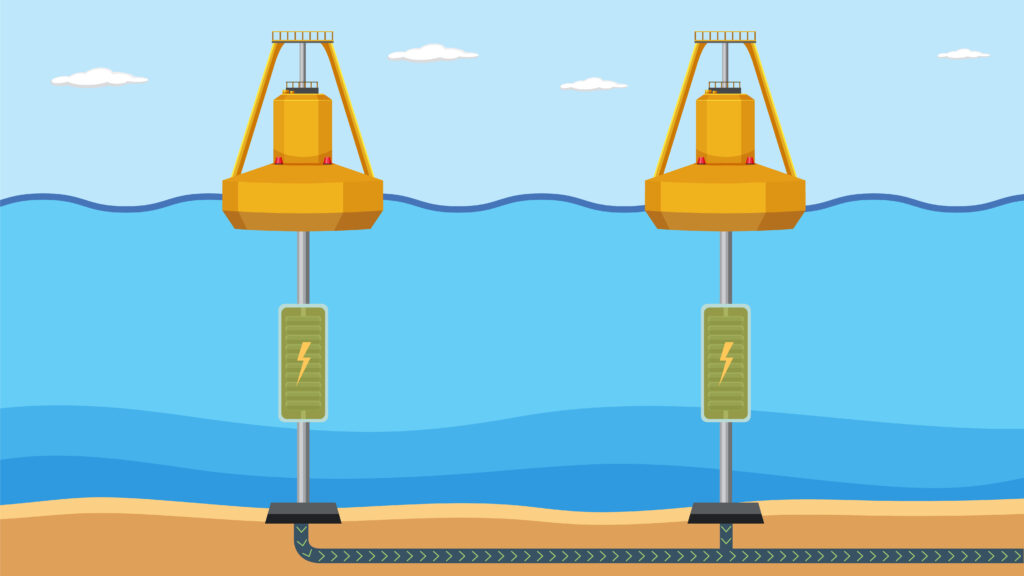“Discover the sustainability of wave energy: Is wave energy renewable? Explore the eco-friendly potential of harnessing ocean waves as a renewable energy source and its impact on the environment. Find answers and insights here.”

Table of Contents
Understanding Wave Energy
Ocean waves are used as the source of renewable energy known as “wave energy,” sometimes known as “ocean wave power.” It entails transforming the kinetic energy caused by the waves’ innate movement into useful electricity. Wave energy offers a more environmentally friendly and sustainable alternative to fossil fuels, which are limited resources that also contribute to environmental deterioration.
1. Abundant and Endless Source
Wave energy is regarded as renewable in large part due to its abundance. Oceans all across the world are constantly moving thanks to the moon’s and sun’s gravitational pull. The virtually infinite supply of wave energy ensured by this continual motion makes it a resource that won’t run out anytime soon.
Our seas are so large that there are a lot of places where wave energy may be used. Wave energy farms might be built in coastal places all over the world, and by connecting different regions with different wave intensities, more energy can be produced overall.
2. Low Environmental Impact
Wave energy has a substantially lower environmental effect than conventional fossil fuels. Fossil fuel extraction frequently results in damaging emissions and pollution. Contrarily, using wave energy results in less greenhouse gases and other pollutants, so assisting in reducing climate change and safeguarding the environment.
Buoys and oscillating water columns are examples of wave energy devices that are made to function with the least possible impact on marine ecosystems. The impact on marine life is kept to a minimum by careful deployment and monitoring, while technological improvements keep making these devices more durable.
3. Predictable and Consistent
One significant benefit of wave energy is the regularity of wave patterns. Ocean waves have a more steady and predictable behavior than certain other renewable sources, such as solar or wind, which might be intermittent. It is possible to plan and use energy more effectively because of this constancy.
Energy suppliers may anticipate wave energy potential correctly and make operational plans based on advanced wave prediction algorithms and data analysis. This predictability increases grid stability by lowering supply swings, which also increases energy production efficiency.
4. Minimal Visual Impact
Facilities for wave energy can be placed strategically offshore to reduce their aesthetic impact on coastal environments. The majority of the wave energy equipment may be located underwater, protecting the visual attractiveness of coastal areas, unlike big solar arrays or tall wind turbines.
In addition to being aesthetically inconspicuous, underwater wave energy devices are more resistant to harsh weather than above-water renewable energy installations, which can be problematic. As a result, wave energy is a dependable and durable choice for coastal towns.
5. Reduces Reliance on Fossil Fuels
Adopting wave energy can help us become less dependent on finite fossil fuel supplies. Switching to renewable energy sources like wave energy can improve energy security and stabilize energy costs when traditional energy sources become increasingly scarce and expensive.
Additionally, the use of wave energy improves energy independence for nations with extensive coastal resources by reducing our reliance on the importation of fossil fuels. Significant geopolitical and economic advantages may result from this decrease in dependency on foreign energy supplies.
6. Job Creation and Economic Growth
The creation and upkeep of wave energy plants can foster economic expansion and job possibilities. The wave energy industry has the ability to provide a variety of professional and unskilled occupations in many locations, from research and design through installation and operation.
Investing in regional wave energy projects may boost coastal economies by creating jobs and assisting neighborhood businesses. A competent workforce in fields connected to renewable energy technologies may be fostered by the expansion of the wave energy sector, which would further benefit the economy.
7. Harnessing Untapped Potential
Wave energy is still largely unexplored globally despite its promise. We can maximize the use of this renewable resource and support the development of a more varied and resilient energy mix by making investments in infrastructure and research.
Large coastal nations have a special chance to use their inherent wave energy potential and take the lead in the renewable energy industry. Unleashing this unrealized potential benefits not just individual countries but also global efforts to reduce carbon emissions.
8. Integration with Existing Infrastructure
It is possible to connect wave energy technologies with already-built coastal infrastructure, such as ports and offshore platforms. Wave energy is now a practical and viable choice for many places because to this compatibility, which makes the adoption process easier and lowers the need for significant adjustments.
We can reuse existing infrastructure for wave energy generation by adapting it, such as abandoned offshore oil rigs. By putting otherwise idle assets to work, this not only lowers costs but also helps the switch to renewable energy go more smoothly.
9. Mitigating Coastal Erosion

By lowering the energy of incoming waves, wave energy devices can be installed to assist prevent coastal erosion. In addition to helping to preserve coastal ecosystems, this protective role also helps to protect coastal settlements from the effects of harsh weather and increasing sea levels.
Wave energy installations operate as natural barriers, reducing the force of waves and defending exposed beaches in places prone to coastal erosion and storm surges. For areas dealing with the effects of climate change, wave energy is a desirable choice because of its dual functioning.
10. Technological Advancements
The efficiency and economics of wave energy technologies are always being improved. We may anticipate even larger advances in wave energy harvesting as this field of study and invention advances, making wave energy a more realistic and alluring renewable energy source.
For wave energy devices, researchers are always experimenting with novel materials and designs in an effort to improve their functionality and lower production costs. The wave energy industry is moving toward a more sustainable future because to innovations like wave-to-wire systems and improved energy conversion technologies.
Conclusion
In conclusion, wave energy is unquestionably renewable and has enormous potential to favorably transform the energy industry. The advantages of wave energy over fossil fuels include its unlimited supply, minimal environmental effect, predictability, potential for job development, and ongoing technical breakthroughs. It is obvious that wave energy will be essential in guiding us toward a greener, cleaner, and more sustainable future as we negotiate the difficulties and seize the possibilities. We can significantly reduce our carbon footprint and provide a better future for future generations by embracing wave energy and investing in its growth.
Frequently Asked Questions (FAQ)
1. Is wave energy truly renewable?
Yes, wave energy is a renewable energy source. It is derived from the motion of ocean waves, which are perpetually driven by the gravitational forces of the moon and the sun. As long as the Earth’s oceans continue to exist and experience tidal interactions, wave energy will remain an abundant and renewable resource.
2. How does wave energy work?
Wave energy is harnessed using various technologies, such as floating buoys, oscillating water columns, or submerged structures. As waves pass through these devices, they create mechanical movements, which are then converted into electrical energy using generators or turbines.
3. What are the environmental benefits of wave energy?
Wave energy has several environmental benefits. Unlike fossil fuels, wave energy does not produce harmful emissions or contribute to climate change. It has a minimal carbon footprint and helps reduce greenhouse gas emissions. Additionally, wave energy devices are designed to have minimal impact on marine ecosystems when properly placed and monitored.
4. Is wave energy predictable and consistent?
Yes, one of the advantages of wave energy is its predictability and consistency. Ocean waves follow predictable patterns based on factors such as tidal cycles and weather conditions. This predictability allows for better energy planning and reliable power generation.
5. How does wave energy compare to other renewable energy sources like solar and wind?
Wave energy complements other renewable sources like solar and wind. While solar energy is dependent on sunlight availability and wind energy relies on wind patterns, wave energy remains relatively consistent and is not affected by weather conditions. By diversifying the energy mix with wave energy, we can enhance grid stability and reduce dependence on intermittent renewables.
6. Can wave energy reduce coastal erosion?
Yes, the installation of wave energy devices can help mitigate coastal erosion. By reducing the energy of incoming waves, these devices act as natural barriers, protecting vulnerable coastlines from erosion and storm surges.
7. What challenges does wave energy face?
Wave energy still faces certain challenges, including high upfront costs of infrastructure installation and the need for suitable coastal locations with sufficient wave intensity. Additionally, the potential impact on marine ecosystems requires careful consideration and mitigation strategies.
9. Is wave energy widely adopted globally?
Currently, wave energy remains largely untapped on a global scale, but interest and investments in this renewable source are increasing. Some countries with extensive coastlines and strong commitments to renewable energy have already started implementing wave energy projects.
10. What does the future hold for wave energy?
The future of wave energy looks promising. Continued technological advancements, research, and development are expected to improve the efficiency and cost-effectiveness of wave energy systems. As the world seeks cleaner and more sustainable energy solutions, wave energy will likely play an increasingly significant role in shaping our energy landscape.

